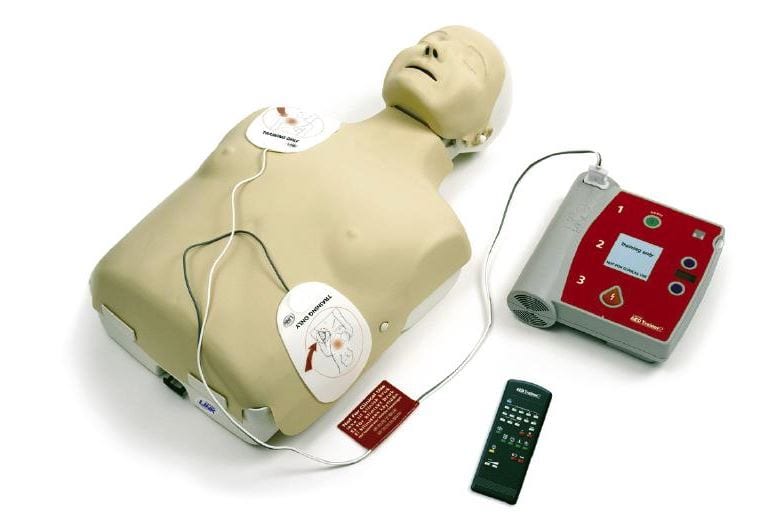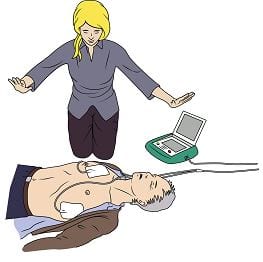
Automated External Defibrillators (AEDs)
AEDs are life saving devices.
Information on California laws regarding the use and placement of AEDs below.

What is an AED?
- An automated external defibrillator (AED) is a lightweight, portable device that delivers an electric shock through the chest to the heart. The shock can potentially stop an irregular heartbeat (arrhythmia) and allow a normal rhythm to resume following sudden cardiac arrest (SCA).
Why use an AED?
- AEDs are used to treat Sudden Cardiac Arrest (SCA), when the heart suddenly and unexpectedly stops beating. A shock from an AED can greatly improve the survival rate of the victim, by potentially restarting the heart. According to the American Heart Association, 23% of SCA’s are “shockable.”
Am I required to have an AED?
- While individual people are not required to have AED’s, new state law does require a number of buildings and businesses to have these devices available to the public. Information regarding the specific requirements can be found via the links on this page and through your local building codes.
Am I liable if I use an AED?
- If a person provides emergency care that is within their scope of training, they are protected by California Health and Safety Code §1799.102 that says, “No person who in good faith, and not for compensation, renders emergency medical or nonmedical care at the scene of an emergency shall be liable for any civil damages resulting from any actor omission commonly known as “The Good Samaritan Law”. Civil Code §1714.21 provides liability protection specific to the use of AED’s.
Information about buying an AED
- The US Food and Drug Administration (FDA) requires a physician sign for the delivery of an AED or prescribe an AED because the AED is a medical device. The FDA has granted a Phillips model of AED over the counter status where a physician does not have to sign for the device.
AED’s for Schools
1. Education Code §35179.6
- Requires school districts or charter schools that have interscholastic athletic programs to acquire at least one AED for each school within the school district or the charter school to be available on campus and maintained.
- Allows schools to seek funding to purchase and maintain AEDs and identifies liability protections for the use of the AED. AED placement and use must be in compliance with H&S code 1797.196
- Encourages schools to provide students with training and information on the use of AEDs.
AED’s for Public Pools
1. Health and Safety Code 116045 and §116046
- Requires certain public swimming pools to provide lifeguard services and to acquire and make available an Automated External Defibrillator (AED) during pool operations.
AED’s for Commuter Rail
1. Public Contract Code §6971 and Public Utilities Code §99175
- Requires a public entity that operates, or contracts for the operation of, a commuter rail system to ensure that each train has an AED as part of its safety equipment.
AED’s for Business/Building Requirements
1. Health and Safety Code §19300
- Requires specified buildings constructed or renovated on or after January 1, 2017 to have an AED available for use and provides liability protection to the person or entity who purchases the AED for its use. AED placement and use must be in compliance with H&S code 1797.196
2. Health and Safety Code §104113
- Requires health studios to acquire, maintain and train personnel in the use of an AED. Also provides liability protection to the health studio if the AED is used. Health studio is defined as a facility permitting the use of its facilities and equipment or access to its facilities and equipment, to individuals or groups for physical exercise, body building, reducing, figure development, fitness training, or any other similar purpose, on a membership basis. This excludes hotels or similar business. AED placement and use must be in compliance with H&S code 1797.196
- Requires the Department of General Services in consultation with EMSA, ARC and AHA to develop and adopt policies relative to the placement, training and use of AEDs in state owned or leased buildings.
4. Health and Safety Code §1538.55
- Requires Adult Residential Facilities for Persons with Special Health Care Needs to report to the State Department of Developmental Services (within 24 hours) the use of an AED.
AED’s for Civil Liability
1. Civil Code 1714.21, Health and Safety Code §1797.190, and §1797.196
- Grants certain protections from civil liability for lay rescuers who use an AED as long as the use and placement of the AED is compliant with 1797.196 of the Health and Safety Code. §1797.196 of the Health and Safety Code requires the AED be maintained and tested according to manufacturer guidelines, records be maintained of maintenance and use, training be provided in the use of AEDs and reporting to the Local EMS Agency of the location of any AED if one is acquired.
Resources
American Heart Association:
American Red Cross:
https://www.redcross.org/take-a-class/aed
AED Law Center:
FDA Consumer:
https://www.fda.gov/ForConsumers/ConsumerUpdates/ucm386240.htm
https://www.fda.gov/MedicalDevices/ProductsandMedicalProcedures/CardiovascularDevices/ucm344669.htm
Mayo Clinic:
